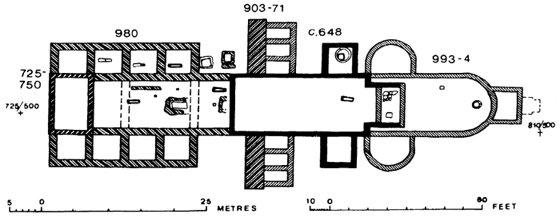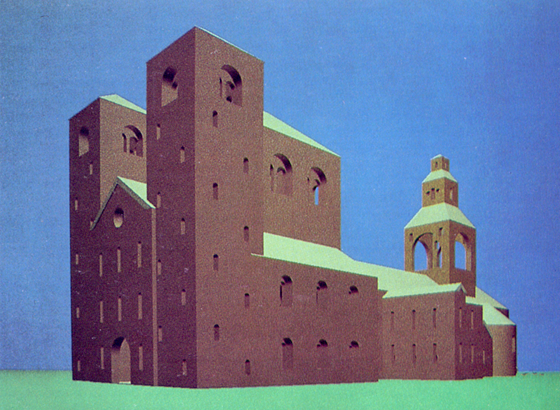| 3DVisA Resources
3DVisA Index of 3D Projects: Archaeology
Old Minster, Winchester, Hampshire, UK
This pioneering computer project was concerned with digital recreation of the first, Anglo-Saxon Cathedral at Winchester, Hampshire, UK.
It is believed to be the earliest application in the UK of 3D computer modelling to visualise archaeological data.
The church was founded by King Cenwealth of Wessex. It was built c. 648. Following the appointment of Bishop Wini around 662, the church served as the cathedral for the diocese of Wessex.
Swithun, the bishop of Winchester from 852 to 862, later canonised, and other saints and kings were buried here.
This Anglo-Saxon church is known as Old Minster by contrast to another church, the New Minster that was built c. 901-3 immediately to the north.

Fig. 1. Plan of the Old Minster in Winchester © Birthe Kjølbye-Biddle and the Winchester Excavations Committee.
Reproduced with kind permission after Kjølbye-Biddle, B. (1986), The 7th century minster at Winchester interpreted, p. 198.
The Anglo-Saxon Old Minster was rebuilt and enlarged in the 10th century, only to be demolished in 1093. The stone was used for the construction of the
Norman cathedral. The partly preserved, 2.5 m wide foundations of the Old Minster were excavated in the 1960s by a team of archaeologists led
by Birthe Kjølbye-Biddle and Martin Biddle of the Winchester Research Unit. The plan of Old Minster in its final form as uncovered by the excavations is marked out in brick
on the grass north of the present cathedral.
The church originally consisted of a nave (c. 22x11m), a rectangular chancel and transepts. Later additions included towers and projections
at the west end of the nave, as well as an apse at the east end of the chancel, and two lateral apses at the north and south walls of the chancel respectively.
The Old Minster was modelled on Carolingian architecture, but its exact appearance is unknown. There are various theoretical possibilities how it might have
looked, based on interpretation of archaeological data and other evidence. The aim of the computer visualisation was to present the results of archaeological investigation to the general public.
The virtual church is a complex structure: it has two imposing, nine-storey west towers with a number of openings, including biforia in the top storey.
Apses were added to the north and south walls of the chancel, and the chancel topped with an aedicule. The unit of measurement used for the 7th-century church appears to have been the Long Roman foot (the Drusian foot) of 0.333m.
In this foot the three-dimensional reconstruction is based upon the regular geometry of the plan of the church.

Fig. 2. The WINSOM computer model of the Old Minster, Winchester.
© Winchester Excavations Committee and IBM, UK. Reproduced after Information Technology in Humanities Scholarship, British Library Research and Development Report 6097, London 1993, p. 14.
The 3D computer model was based on a complete set of drawings and 3D reconstructions provided by Birthe Kjølbye-Biddle.
These data were used earlier to construct a large-scale physical model of the minster for the Anglo-Danish exhibition, The Vikings in England, held in 1981-1982.
The computer model was created by the IBM UK Scientific Centre using WINSOM (WINchester SOlid Modeller) and was the first application of this software to archaeological data. A two-minute animated tour
of the model, created by Andrew G.N. Walter, was presented at the exhibition Archaeology in Britain since 1945, held at the British Museum in 1986.
A number of external and internal views of the minster were available, including the tomb of St Swithun in the nave, as well as 'fly-through' views.
Project dates: 1984-86
Resource status: The actual computer model is with the IBM UK; A CD of the updated model is forthcoming in: Kjølbye-Biddle, B. and Biddle, M., The Anglo-Saxon Minsters of Winchester, Winchester Studies 4.i, Oxford University Press.
Contributors: Archaeological data provided by Dr Birthe Kjølbye-Biddle, Winchester Research Unit, 19 Hamilton Rd., Oxford OX2 7PY; Computer graphics and modelling by Andrew G.N. Walter and Mike Stanley; animation of the model by Andrew G.N. Walter,
IBM UK Scientific Centre’s Graphics Research Team, Hursley Park, Winchester SO21 2JN.
Sources and further details:
Burridge, J. M., Collins, B. M., Galton, B. N., Halbert, A. R. et al. (1989), ‘The WINSOM solid modeller and its application to data visualization’,
IBM Systems Journal, Vol. 28, No. 4, pp. 548-568,
PDF version (accessed 28 November 2006).
Kjølbye-Biddle, B. (1986), 'The 7th century minster at Winchester interpreted', in Butler, L.A.S. and Morris, R.K. (eds), The Anglo-Saxon Church: Papers on History, Architecture and Archaeology in Honour of Dr. H.M. Taylor, Council for British Archaeology Research Report 60, London, pp. 196-209. (Incomplete PDF version, pp. 196-200 only). The plan of the Old Minster in Winchester reproduced above is Fig. 135 on p. 198.
Kjølbye-Biddle, B. (1993), 'Old Minster, St. Swithun's Day 1093' in John Crook (ed.), Winchester Cathedral. Nine Hundred Years, Chichester, pp. 13-20.
Kjølbye-Biddle, B. and Biddle, M. (2006), Correspondence with 3DVisA, 27 November and 5 December.
Kjølbye-Biddle, B. and Biddle, M., The Anglo-Saxon Minsters of Winchester, Winchester Studies 4.i, Oxford University Press (forthcoming).
Longworth, I. and Cherry, J. (eds) (1986), Archaeology in Britain since 1945: new directions, exh. cat., London: British Museum Publications.
[N.N.] Information Technology in Humanities Scholarship. British Library Research and Development Report 6097, British Library Research and Development Department and the British Academy, London 1993, p 14.
Reilly, P. (1988), ‘Data Visualisation: Recent Advances in the Application of Graphic Systems to Archaeology’, IBM UKSC Report 185, March, pp. 29-33.
Reilly, P. and Rahtz, S.P.Q. (eds) (1992), Archaeology and the Information Age: a global perspective, London and New York: Routledge, pp. 152-4 (available through Google Books).
The Vikings in England and in their Danish Homeland, exh. cat., Danish National Museum, Brede-Copenhagen, 11 April – 16 August 1981; Prehistoric Museum, Moesgård, Arhus, 5 September – 31 December 1981;
Yorkshire Museum, York, 3 April – 30 September 1982, London: The Anglo-Danish Project, 1981, pp. 165-7 and Entry J16 on p. 170.
Record compiled by Anna Bentkowska-Kafel, 5 December 2006. Last updated: 12 March 2012.
3DVisA gratefully acknowledges the help of Dr Birthe Kjølbye-Biddle and Professor Martin Biddle with preparation of this record.
© Winchester Research Unit, IBM UK and 3DVisA.
Back to the list of 3D projects
|
